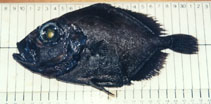| Family: |
Oreosomatidae (Oreos), subfamily: Oreosomatinae |
| Max. size: |
42.5 cm TL (male/unsexed); max.weight: 2,000.0 g; max. reported age: 140 years |
| Environment: |
bathypelagic; marine; depth range 0 - 1800 m, oceanodromous |
| Distribution: |
Eastern Atlantic: off Mauritania, Gulf of Guinea, Namibia and South Africa. Western Atlantic: off Suriname, southern Brazil and Uruguay. Western Indian Ocean: Mozambique Channel, Walters Bank. Eastern Indian Ocean: East Indian and West Australian Ridge, Australia. South Pacific: New Zealand and off Chile. Records from the North Pacific belong to Allocyttus folletti. Also Ref. 26139). |
| Diagnosis: |
Dorsal spines (total): 5-8; Dorsal soft rays (total): 28-33; Anal spines: 2-3; Anal soft rays: 26-31. Adults blackish black in color; prejuveniles silvery, back greenish with large grey blotches that disappears at about 12 cm (Ref. 6548). |
| Biology: |
Occurs on the continental slope (Ref. 9563), forming large shoals over rough ground near pinnacles and canyons (Ref. 6390). Juveniles are pelagic and inhabit oceanic waters in depths of less than 1000 m (Ref. 27230). They tend to be dispersed over smooth grounds (Ref. 6390). Feeds on shrimps, cephalopods, and fishes (Ref. 6548). The eggs float near the sea surface and the larvae also inhabit surface waters (Ref. 6390). Trawl catch rates for warty oreos, and for oreos in general, show no evidence of vertical migration during day or night (Ref. 27150), even though many of the planktonic species consumed by this species undergo daily migrations within the water column (Ref. 6390). |
| IUCN Red List Status: |
Least Concern (LC); Date assessed: 16 June 2014 Ref. (130435)
|
| Threat to humans: |
harmless |
Source and more info: www.fishbase.org. For personal, classroom, and other internal use only. Not for publication.
